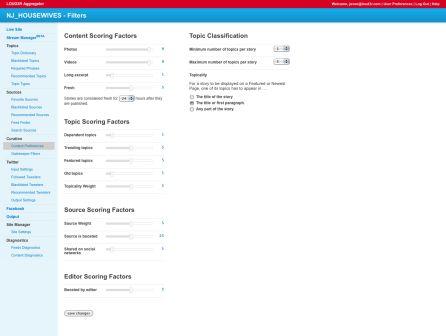LOUD3R Content Curation Platform
Content Curation for Publishing Moves into Marketing with an Emphasis on Quality Content
Increasing editorial productivity as online topic pages multiply to serve niche audiences, has been a prime motivation for publishing’s move to embrace content curation solutions. Now, as marketers increasingly behave as publishers, using timely relevant content to draw and engage target audiences, they too are turning to content curation. Can the curation platforms that perform well in publishing meet marketers’ needs? This product review examines the LOUD3R content curation platform with that question in mind.
NETTING IT OUT
The use of content curation in marketing is gaining steam. As marketers push to understand how they can curate content to attract and engage target audiences, suppliers that have successfully provided solutions for online publishing are broadening their pitches to highlight marketing uses. Between these two camps lies a no-man’s land where long-held assumptions and idiosyncratic language gets in the way of understanding the real fit between capabilities and needs.
It is around the topic of thought leadership collections that the language breakdown occurs most frequently. Publishers seek the most up-to-date stories. By contrast, marketers developing thought leadership collections focus first on “the best” regardless of publication date and then on “what’s happening now…where are things trending?” Real-time news platforms handle the latter easily but tend not to have a solution for developing a collection of “the best” and updating it over time. LOUD3R is a real-time news platform and, like many others, offers only work-around solutions for thought leadership collections.
LOUD3R’s roots in publishing have given it a strong focus on improving the productivity of editors. It uses smart technology to either present the editors with highly relevant content for review or fully automate the publication of a topic page. Marketing use also demands high quality content and efficient handling. LOUD3R finds that the fact that customers spend sometimes only minutes a day curating content translates into increased productivity. Their customers’ results, which include an 11 time increase in organic referral traffic and (separately) a 500 percent increase in monthly return visits, speak to the value provided by the content on the curated site.
Most of LOUD3R’s customers rely on their own internal resources for presentation of the curated content to information consumers. This is another point of difference for marketing uses: most marketers don’t have those resources and therefore need an end-to-end turnkey solution. LOUD3R has begun to take steps to meet that need (e.g., Site Templates based on WordPress, plans for a newsletter capability) and will have to go farther in this area in order to find as much success in marketing use as they have found in publishing.
OVERVIEW OF LOUD3R
Company Background
Founders Lowell Goss and Demetri Spanos launched LOUD3R in September 2008 to create enthusiast portals for consumers in defined segments. The idea was that these real-time content portals would become a substitute for magazines, providing an experience that information consumers could share with fellow enthusiasts online. Goss and Spanos, who had worked in senior roles at Google, MTV, and Yahoo!, started with seed and angel investors and drew Series A investment from the New York Daily News in December 2009. Today they have 11 employees and have grown a client base that includes the New York Daily News, Tribune Company, US News, and Fox Television, among others.
LOUD3R delivers real-time content about any topic to make customers’ sites and social media participation more authoritative and engaging. Soon after launching, the founders realized that the technology had uses outside the publishing industry. Today, one customer uses LOUD3R to find all mentions of a TV program or its actors in social media conversations and either respond or publish the mentions. Another gathers stories about and mentions of the nightclub scene in a city, becoming a hub that draws the nightclub demographic. This client represents itself as a site sponsor, associating its brand with what’s hot. Yet another uses LOUD3R to search social media streams to gain market intelligence and track competitor activity as well as brand mentions. Today a third of LOUD3R’s enterprise customers use the product for marketing.
LOUD3R describes its target markets as traditional and online-only publishers, media companies, agencies and brand marketers. They expect to expand their agency and brand marketer business in 2011.
PRODUCT OFFERING
Overview
LOUD3R is a Software-as-a-Service (SaaS) platform that:
• Aggregates news, blogs, photos, videos and tweets from around the web. Databases and licensed content available by RSS or closed API can also be added to the input stream.
• Provides smart, tunable, automated curation tools and also enables the curator to choose to manually select stories for publication.
• Delivers the curated content to customers’ sites and for posting to Twitter and Facebook
Pricing is generally in the $1,000-$2,000 per month range per topic curated. There is also a one-time setup fee based on the complexity of the work. Custom development is priced by the hour.
Aggregation and Filtering
Customers, with LOUD3R’s tools and assistance as needed, specify their own content taxonomies (e.g., keywords), online sources, preferences for content types, synonyms, required phrases, blacklist phrases, and blacklist sources. Customers can make changes and additions to these specifications at any time using the Curation Platform dashboard.
LOUD3R uses a semantic processing engine that distinguishes words and names appearing in different contexts to aggregate content. For instance, the Robert Smith who is a member of the band The Cure is not confused with the Robert Smith who represented New Hampshire in the U.S. House of Representatives and Senate. Near duplicates as well as exact duplicates are eliminated by clustering them together and choosing the best (or, in the case of a press release, the original).
LOUD3R uses natural language processing and machine learning techniques to evaluate content based on linguistic clues. For instance, a two-line report of sports scores is not confused with in-depth reporting on a game. Relevancy is based on both customer-supplied (see above) and algorithmic (freshness, popularity, source reputation, virality, and others) criteria. Twenty user-tunable aspects of relevancy are used to score content in terms of buzz (freshness, popularity), quality (media, reputation, statistics) and community (comments, shares, submits). Illustration 1 shows the screen curators use to tune the relevancy filters...
Tuning the Relevancy Filters Used in LOUD3R’s Automated Curation
© 2011 LOUD3R
Illustration 1. This screen shows the ease with which customers can tune relevancy settings.
Contact Info:
LOUD3R
Lowell Goss
CEO
Phone: 310.990.0996
Email: lowell@LOUD3R.com
Internet: www.LOUD3R.com
Sign in to download the full article
0 comments
Be the first one to comment.




